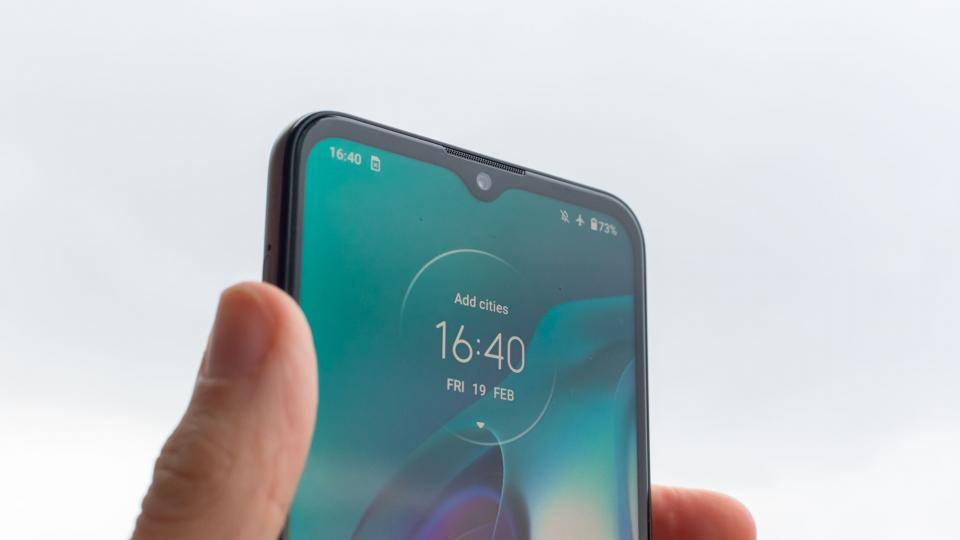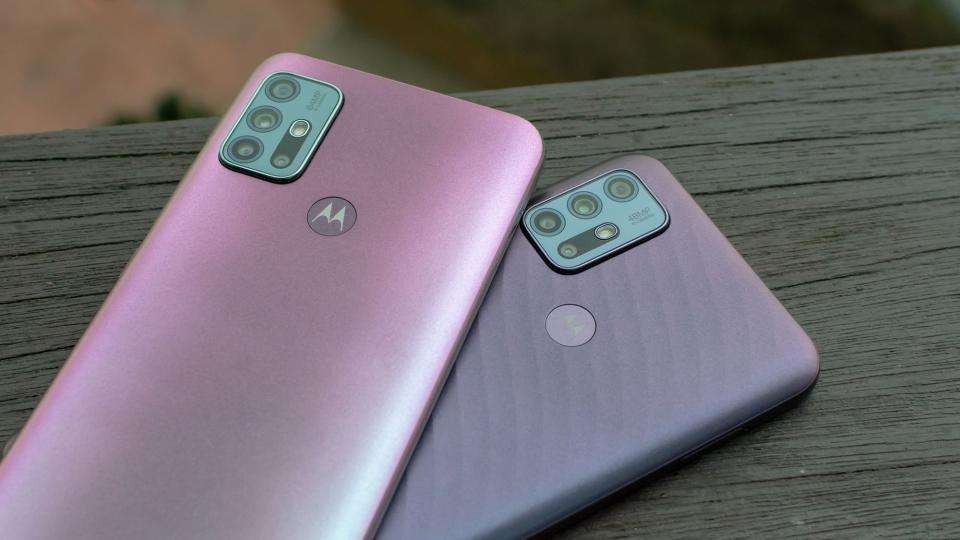With the Moto G30, Motorola has taken a leaf out of Samsung’s phone book. Not in terms of suddenly chasing four-figure handsets or anything, but in mysteriously jumping numbers without warning. We went from the Moto G to the Moto G9 in seven years and then – bang – the Moto G10 and G30 launch at the same time.
Despite the name, the Moto G30 isn’t three times as good as the Moto G10, but it also isn’t three times the price. Costing just £30 more, is the Moto G30 worth the extra money?

Motorola Moto G30 review: What you need to know
Despite the numerical jump, the Moto G30 is very much a budget device. Powered by Qualcomm’s octa-core 2GHz Snapdragon 662 processor and backed by 4GB of RAM, it’s actually a side step from the Moto G9 Power and Play handsets, which have identical internals (the G9 Plus, meanwhile, has a faster Snapdragon 730G processor).

It does, however, come with a handful of improvements. Firstly, the 6.5in 720p screen has a 90Hz refresh rate, for more fluid scrolling. It also theoretically opens the door to 90fps gameplay, but few apps actually support anything over 60fps, and even if they did, the budget Moto G30 wouldn’t be the best to demo them.
Camera-wise, it also gets a boost, featuring similar specs to the quad-camera array on the Moto G9 Plus . You get a 64MP f/1.7 main camera this time around, which is supported by an 8MP f/2.2 ultra-wide lens and two 2MP sensors – one for macro photography and the other to add depth to portrait shots.
Motorola Moto G30 vs Moto G10: What’s the difference?
Side by side, both the Moto G30 and G10 look identical. Both are 6.5in handsets with 720p screens, and it’s really only the wavy pattern on the back of the G10 that gives the game away.

On the inside, however, there are four main areas of difference. The most significant of these is processing grunt. While the Moto G30 gets the same 2GHz Qualcomm Snapdragon 662 as the Moto G9 Play and Power, the Moto G10 gets a considerable downgrade in the form of the 1.8GHz Snapdragon 460.
Then there are three smaller but still notable improvements. The first is in the camera array. While the Moto G30 has a 64MP main camera and 13MP selfie lens, the Moto G10 is downgraded to 48MP and 8MP snappers. The second change is in screen tech: while both devices have 720p IPS displays, the Moto G30 gets the added benefit of a 90Hz refresh rate, while the G10 maxes out at 60Hz. Finally, internal storage is doubled from 64GB to 128GB.
Motorola Moto G30 review: Price and competition
The price difference? The Moto G30 comes in at £160, while the Moto G10 is £130.
It’s quite telling that the strongest competition to the Moto G30 comes from other Moto G handsets. If ever there was a brand in danger of cannibalising itself, it’s Motorola.
Along with the freshly launched Moto G10 and G30, there’s also the £160 Moto G9 Play, which comes in £20 cheaper than the £180 Moto G9 Power. Elsewhere, the Samsung Galaxy A21s is £150, while the Realme 7 launched at £179. If you can really push the boat out, then the Xiaomi Poco X3 NFC is a steal at £200.
Motorola Moto G30 review: Design
The Moto G30 will feel pretty familiar to anybody who has picked up a Moto G handset in recent years. It’s a big, chunky handset with a 6.5in screen dominating the front of the handset, bordered by bezels a couple of millimeters thick. As per usual, this bezel doubles in thickness around the ‘chin’ of the device, and the front-facing camera is tucked away in a notchlette embedded in the middle of the screen’s top.
Flip it over, and it’s plastic all the way. The smooth finish does a pretty good job of imitating matte metal from a distance, but isn’t fooling anybody to the touch. The Motorola logo is in a small indented circle that doubles up as the fingerprint reader on the back, and the quad-camera array is embedded in a rectangular hump in the top left-hand corner.
It’s a decent-looking handset, as per usual from Motorola. And I’m pleased to report that the company’s history of consumer-friendly choices return once again: there’s a 3.5mm headphone jack in the top of the phone, and it also supports microSD cards up to 512GB in size. Alternatively, you can use the slot for a second SIM card if you prefer.
Motorola Moto G30 review: Screen
The 6.5in IPS display has a resolution of 1,600 x 720, which means you get a pixel density of 269ppi. That’s quite low in a world where 1080p and 2K phone displays are common, but it’s still similar to the pixel density you’d get on your average laptop screen, so it’s more than adequate here.
As you might expect, the Moto G30’s display follows the cheap Motorola handset formbook by providing very good performance on a budget. Colour accuracy is solid with 85.9% of the sRGB spectrum covered from a gamut volume of 98.6%, and contrast is good with a ratio of 1775:1. Brightness is a bit of a weak spot, with the screen maxing out at 335cd/m2, but it’s still fine for most environments.
So it’s a good screen – although it is slightly disappointing for those keeping track that every one of those metrics is slightly worse than the cheaper Moto G10. Albeit not in any way that anyone without a colorimeter would notice, of course.
But the Moto G30 has an ace up its sleeve: the panel boasts a 90Hz refresh rate over the Moto G10’s (and almost every other budget handset’s) 60Hz. This makes for a smoother effect when navigating Android and theoretically opens up the potential to 90fps performance in compatible games.
By default, the mode is set to Auto. Here, the OS decides whether to use 60 or 90Hz via an AI algorithm, but you can overrule it and pick whichever you like. You might not want to go all out on 90Hz, however, as the phone will warn you this impacts battery life.
Enabling 90Hz is noticeably smoother, but it’s definitely a subtle effect, and I think I can safely say that nobody will feel particularly shortchanged if they buy a phone without it at the time of writing. Especially with the subsequent knock on to battery life.
Motorola Moto G30 review: Performance
As mentioned in the intro, the Moto G30 offers the same internals as the Moto G9 Play and G9 Power, with a Qualcomm octa-core 2GHz Snapdragon 662 chipset matched with 4GB of RAM. Storage is a generous 128GB, which can be expanded with microSD cards of up to 512GB capacity, should you feel so inclined.
Performance feels good and snappy out of the box, in stark contrast to the £30 cheaper Moto G10. Unsurprisingly, the benchmarks put the phone exactly where you’d expect it to be: level pegging with the Moto G9 Play and Power, but some way behind the Realme 7 and Poco X3 NFC.
The pattern holds in terms of graphical performance too, as the GFXBench tests show. The orange bar where resolution differences are eliminated is the one to pay attention to here, and the Moto G30 is once again equal with the Moto G9 Play – though a some way adrift of the Realme 7’s MediaTek G95 and Poco X3 NFC’s Snapdragon 732G powered output.
As is usual for recent Moto G phones, the Moto G30 really excels in the stamina department. In our looped battery test, the handset’s 5,000mAh cell lasted a 22hrs 30mins before conking out. That’s narrowly behind the Samsung Galaxy A21s, but beats everything else – with the exception of the Moto G9 Power, which is fair enough given that phone is named after its 6,000mAh battery.
It’s worth noting this battery test was taken using the default refresh rate settings. The numbers would drop if you engaged 90Hz mode all the time.
Motorola Moto G30 review: Camera
The Moto G30 gets four cameras – one up on the Moto G9 Power and G9 Play. For your hard-earned cash, you get a 64MP f/1.7 main camera, supported by an 8MP f/2.2 ultra-wide lens and two 2MP sensors (depth and macro). Frankly, I’d prefer just one really good main lens, but it seems the market disagrees with me.
In bright conditions, the Moto G30 performs admirably. Shots are colourful and capture plenty of detail as this photo of my local church shows.
This holds even when zoomed in, though it’s a touch disappointing that the £30 cheaper Moto G10 seems to suffer from less visual blur at this level of magnification.
It’s also slightly odd that while the Moto G10 lets you get a full 48MP shot if you choose, the Moto G30 only lets you have the pixel-binned 16MP version from its 64MP lens. Given the quality of pixel binning on other handsets (including the Moto G10) I’d be surprised if it’s a feature many people will miss, and it’s possible Motorola will patch it in in a software update, but it’s a strange omission all the same.
As you might expect, the phone isn’t quite as strong in conditions where light is at a premium. Here’s a shot taken in my garden at sunset on a blustery day (hence the blurring on some of the plants).
Detail is lost a little, but perhaps not as much as you’d expect. And when zoomed in, you can see the Moto G30 showing its class by having less blur and visual noise than the Moto G10.
Both are excellent, considering the low price of entry. And the 13MP front-facing selfie camera is equally solid. Aggressive beautification effects are disabled by default, and that’s a sensible decision as you can see when I gradually enable them in the samples below.
As with the Moto G10, there aren’t any choices when it comes to video capture. Footage is shot at 1080p at 30fps with some kind of stablisation in place. Video quality is a touch sharper, but it still struggles with sudden movements.
Motorola Moto G30 review: Verdict
All in all, the G30 is yet another solid budget phone from Motorola, and well priced at £160.
But the company’s myriad budget options raise a dilemma here. While there are undoubtedly improvements over the G9 Play, does the addition of a 90Hz screen, an ultra-wide camera lens and double the storage (when both have microSD card support) change anything for most people?
I’d argue probably not, and given phone prices only go in one direction, the majority of budget buyers would probably be better served looking for discounts on the last generation instead. After all, they have identical internal performance thanks to the shared chipset.
It’s still a great phone for the money, but for a handset with a name that implies a multi-generational leap (21 generations, to be exact) it feels like evolution rather than revolution. Mo’ Motos, mo’ problems.
|
Processor |
Octa-core Qualcomm Snapdragon 626 (4 x 2.0GHz, 4x 1.8GHz) |
|
RAM |
4GB |
|
Screen size |
6.5in |
|
Screen resolution |
1,600 x 720 |
|
Pixel density |
269ppi |
|
Screen type |
IPS |
|
Screen refresh rate |
90Hz |
|
Front camera |
13MP, f/2.2 |
|
Rear camera |
64MP, f/1.7; 8MP, f/2.2 (ultra-wide); 2MP, f/2.4 (depth), 2MP, f/2.4 (macro) |
|
Flash |
LED |
|
Dust and water resistance |
IP52 water repellent |
|
3.5mm headphone jack |
Yes |
|
Wireless charging |
No |
|
USB connection type |
USB-C |
|
Storage options |
128GB |
|
Memory card slot (supplied) |
Yes, up to 512GB |
|
Wi-Fi |
802.11 a/b/g/n/ac |
|
Bluetooth |
5 |
|
NFC |
Yes |
|
Cellular data |
4G |
|
Dual SIM |
Yes (shared with microSD) |
|
Dimensions (WDH) |
75.73 x 9.14 x 165.22mm |
|
Weight |
197g |
|
Operating system |
Android 11 |
|
Battery size |
5,000mAh |











